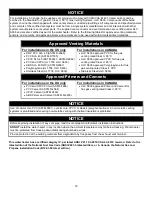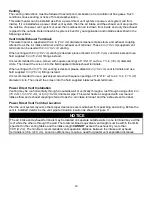
8
Figure 2
– Condensate Elbow with Trap
*Outlet of condensate trap must not be higher than outlet of condensate elbow
Condensate Neutralization
The condensate draining from the water heaters covered in this manual have PH levels between 4.3 and 5.0.
Install a commercially available neutralizing kit if required by local code.
NOTE:
Lower PH levels are acidic. Do
NOT
connect a metal drain line, such as copper, to the water heater for
this reason.
Cleanout
These models are equipped with a cleanout opening to aid in removal of hard water deposits from the tank
bottom. If this water heater operates under hard water conditions, the following should be performed at least
every 3 months: Turn OFF the water supply and drain the water heater. Remove the cleanout jacket cover and
tank cover. When cleaning the tank, care must be taken to avoid trying to break deposits loose as this could
damage the glass lining and shorten the life of the water heater. After cleaning, inspect gasket and reuse or
replace, re-install the cleanout tank cover and jacket cover, and refill with water. Refer to Section X:
Maintenance (page 50) for the procedures for filling and draining the water heater
.
Powered Anode System
The powered anode system provides corrosion protection to the tank by supplying a low voltage current to the
titanium anode rods and then periodically comparing this current with the potential between the anode rod and
tank wall to make corrections. The powered anode system is designed to extend the tank life without requiring
anode rod replacement. The powered anode system consists of titanium powered anode rods and a powered
anode control module located on the control panel. More details on the powered anode system are in Section
X: Maintenance (page 50).
Dishwashing Machine Requirements
All dishwashing machines meeting the National Sanitation Foundation requirements are designed to operate
with water flow pressures between 15 and 25 lbs/in
2
. Flow pressures above 25 lbs/in
2
, or below 15 lbs/in
2
, will
result in improperly sanitized dishes.
The National Sanitation Foundation also recommends circulation of 180°F
(82°C)
water. Where this is done,
the circulation should be very gentle so that it does not cause any unnecessary turbulence inside the water
heater. The circulation should be just enough to provide 180°F
(82°C)
water at the point of take-off to the
dishwashing machine. Adjust flow by means of the valve in the circulation line.
Summary of Contents for LUHE120T
Page 42: ...42 BMS Wiring Diagram...
Page 44: ...44 Lighting and Shutdown Instructions Figure 31 Lighting Instruction Label...
Page 62: ......
Page 63: ......









































